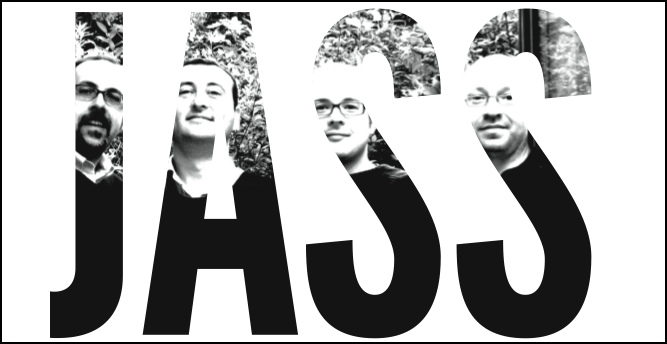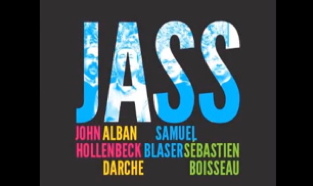JASS
John Hollenbeck drums & percussion
Alban Darche tenor saxophone
Samuel Blaser trombone
Sébastien Boisseau double bass
JASS as in John, Alban, Samuel, Sébastien. Or as in jass, a centuries-old card game for four players, also called chibre, that is popular to this day in Switzerland and in the Austrian region of Voralberg. Or also as in jass, the term used by the Original Dixieland Jass Band lead by Nick La Rocca in March 1917 for the very first jazz-album recording.*
Thus Jass can be viewed as a semantic connection of little importance or simply an amusing etymological coincidence.
One might also suppose that some perceptive intuition, chance encounters and unplanned events such as Alban Darche’s admiration for John Hollenbeck’s Claudia Quintet and his fortuitious meeting with their drummer, the development of a real bond between Samuel Blaser and Sebastien Boisseau or the playfulness shared by the four protagonists have guided them to reveal an aesthetic glee generated by a music both modern and deeply rooted in jazz history. A music that is eminently collective, that is expertly composed but yet its natural flow allows the meaning to emerge as much in the silences as in the musical motif wrought from listening to each other’s ideas and feelings.
A first concert in Berlin in July 2011 and later, an artist’s residency in Nantes in January 2012 (where the current album was recorded ) were sufficient for these four highly demanding musicians to create, in such a natural fashion, a striking sequence of original themes whilst maintaining the group performance at its heart, whilst keeping in check demands of organisation and balance in order to allow free-flowing elements of interference, of effervescence, of intoxication and yet avoiding being side-tracked on an excess or effusiveness.
As compact and well-constructed as it appears, this music cannot be easily encapsulated by one single interpretation. It invites the listener to create one’s own impression derived from the different alternatives suggested by it’s framework and networked connections which suggest that at any moment anything is possible. The precise attention given to the form of each piece and the constant concern for a clear structure are a fertile basis for the melodic voice and the many micro-narratives which intertwine consistently on a palette of incandescent chromatics.
Bernard Aimé
translation by Catherine O’Mahony
*The dictionnary of jazz informs us that jass (or jazz) is generally associated with dance, with vitality and with the sexual act. “Chibre” is an old slang word though still used in the 20th century (by Jean Genet for example) that refers to the male organ, There is, however, no reason to speculate about the potential eroticism of the music created by JASS !

No D from the album JASS
sounds
press
photos/videos
downloads
“JASS challenges, celebrates and, in its own way, defines the spirit of jazz. It could be one of the bands that will play a prominent role in moving jazz forward in its latest stage of evolution and hopefully will prevent this great music from dying the death that it has reportedly been dying for the past 50 years.” – Terrell Holmes, The New York City
Jazz Record

 MENU
MENU









